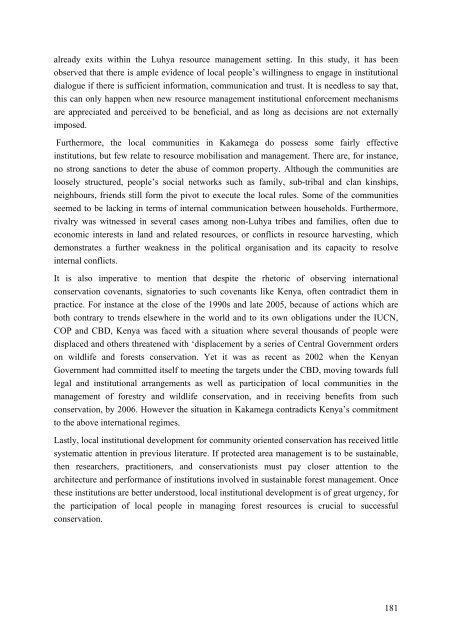THE UNIVERSITY OF LEIPZIG
THE UNIVERSITY OF LEIPZIG
THE UNIVERSITY OF LEIPZIG
Create successful ePaper yourself
Turn your PDF publications into a flip-book with our unique Google optimized e-Paper software.
already exits within the Luhya resource management setting. In this study, it has been<br />
observed that there is ample evidence of local people’s willingness to engage in institutional<br />
dialogue if there is sufficient information, communication and trust. It is needless to say that,<br />
this can only happen when new resource management institutional enforcement mechanisms<br />
are appreciated and perceived to be beneficial, and as long as decisions are not externally<br />
imposed.<br />
Furthermore, the local communities in Kakamega do possess some fairly effective<br />
institutions, but few relate to resource mobilisation and management. There are, for instance,<br />
no strong sanctions to deter the abuse of common property. Although the communities are<br />
loosely structured, people’s social networks such as family, sub-tribal and clan kinships,<br />
neighbours, friends still form the pivot to execute the local rules. Some of the communities<br />
seemed to be lacking in terms of internal communication between households. Furthermore,<br />
rivalry was witnessed in several cases among non-Luhya tribes and families, often due to<br />
economic interests in land and related resources, or conflicts in resource harvesting, which<br />
demonstrates a further weakness in the political organisation and its capacity to resolve<br />
internal conflicts.<br />
It is also imperative to mention that despite the rhetoric of observing international<br />
conservation covenants, signatories to such covenants like Kenya, often contradict them in<br />
practice. For instance at the close of the 1990s and late 2005, because of actions which are<br />
both contrary to trends elsewhere in the world and to its own obligations under the IUCN,<br />
COP and CBD, Kenya was faced with a situation where several thousands of people were<br />
displaced and others threatened with ‘displacement by a series of Central Government orders<br />
on wildlife and forests conservation. Yet it was as recent as 2002 when the Kenyan<br />
Government had committed itself to meeting the targets under the CBD, moving towards full<br />
legal and institutional arrangements as well as participation of local communities in the<br />
management of forestry and wildlife conservation, and in receiving benefits from such<br />
conservation, by 2006. However the situation in Kakamega contradicts Kenya’s commitment<br />
to the above international regimes.<br />
Lastly, local institutional development for community oriented conservation has received little<br />
systematic attention in previous literature. If protected area management is to be sustainable,<br />
then researchers, practitioners, and conservationists must pay closer attention to the<br />
architecture and performance of institutions involved in sustainable forest management. Once<br />
these institutions are better understood, local institutional development is of great urgency, for<br />
the participation of local people in managing forest resources is crucial to successful<br />
conservation.<br />
181






